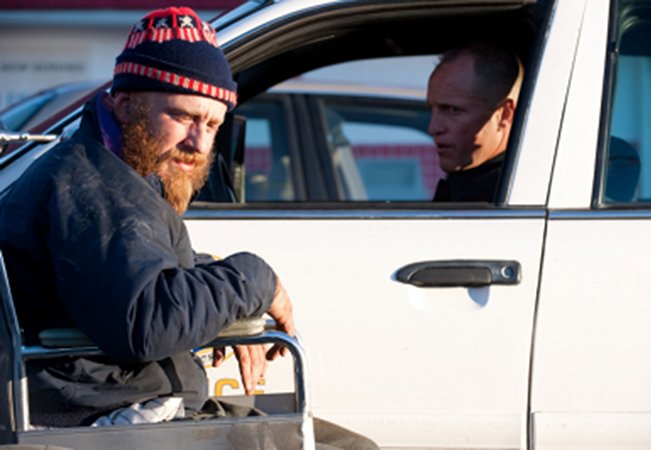
Something about procedural cop dramas makes them inherently powerful, and director Oren Moverman’s Rampart is no exception.
Millenium Entertainment brings this intense feature film—about an arrogant, macho cop (played by Woody Harrelson) on an emotional downward spiral—to theaters this Friday, February 10th. Many of the reviews to have come out since the film’s premiere at the 2011 Toronto International Film Festival focus on Harrelson’s gritty performance as the corrupt cop Dave Brown. But much of the grittiness of the film itself comes from its visual style, which took a special creative approach to achieve.
Rampart’s script, co-written by Moverman and James Ellroy (who wrote the novel L.A. Confidential), puts Harrelson’s veteran police officer in 1999 Los Angeles, where he works to take care of his family and struggles for his own survival. To craft the film’s images, Moverman re-teamed with cinematographer Bobby Bukowski, who shot Oren Moverman’s highly regarded indie debut (and two-time Oscar nominee) The Messenger.
At first, the characters in Rampart are depicted in a strong, unforgiving light, even in close-up. But as the story progresses, Harrelson’s character slowly loses his grip, and to visually express his descent, Bukowski and Moverman used images that show him in partial and broken reflections. By the end of the film, Officer Brown is an almost ghost-like, fleeting presence on the screen.
Moverman and Bukowski also devised a shooting style that introduced available light, extensive handheld work and an “on-the-fly” approach that utilized little blocking and rehearsal.
Bukowski notes that the lines between pre-production, production and post-production have become more and more blurred, which is certainly true in the case of Rampart. The film’s team was interested in shooting on the ARRI Alexa, and they engaged with Burbank, California-based post facility FotoKem early in the creative process to establish the workflow they would need later on. FotoKem proceeded to devise technical solutions that made the ARRI Alexa fit perfectly with the moviemakers’ approach.
“Long before we were shooting anything on the set, we were doing copious testing on the look,” says Bukowski. “Oren and I were mining for the right process. The DI [digital imaging] expertise and tools we employed at FotoKem were very valuable throughout in rendering our vision as artists on this film.”
The SxS-to-ProRes 4444 approach, which Moverman and Bukowski elected to use on Rampart, uses a card-slot module on the side of the camera, leaving the camera operator—in this case, Bukowski—free to follow the action without worrying about cables. “This was one of the first—if not the first—feature films to use the SxS module to shoot directly to ProRes 4444 files,” notes FotoKem vice president Mike Brodersen. “We did quality tests that showed the format holds up beautifully, with no obvious compression issues. The images are recorded in Log C, which allows the full dynamic range of the Alexa to be captured even on relatively ‘lightweight’ media. The ease of media management and the lighter files, without the need for a big recorder or tethering, was important to Bobby [Bukowski] in this case.”
The SxS cards were downloaded on set, where the digital imaging technician (DIT) used a Truelight system to create a variety of looks for the footage using lookup tables, or LUTs. Those LUTs were then sent, along with the rest of the media, to FotoKem, where they would be applied to images as a color grade and checked against the reference images provided by the production. After that was done, FotoKem could create dailies and the AVID media files needed by Rampart’s editorial team, which were then sent wirelessly to the film’s editorial offices in New York.
During the digital intermediate phase, Moverman and Bukowski could fine-tune their footage to better depict Los Angeles light as, in Bukowski’s words, “assaultive and corrosive.” “The DI was a major tool in rendering our vision as artists on this film,” he continues. “If I asked Oren if I should push the highlights brighter, or make the blacks blacker, his answer was always yes. The colors are quite saturated and the highlights are often at the point of peaking. The blacks are completely black, sometimes with no detail.”
Rampart co-producer Luca Borghese appreciated the smoothness of the workflow. “FotoKem was able to remove a lot of the steps from the tapeless process that a dailies workflow can get bogged down in,” he recalls. “And because of the media management system that FotoKem has set up, they were able to complete the online of the project in three days. We were fully conformed less than a week after picture lock. Starting from nothing, that’s pretty impressive. The final product is extreme and beautifully artistic, a real achievement from the perspective of color.” MM
Photo courtesy of Millennium Entertainment.
Share:



